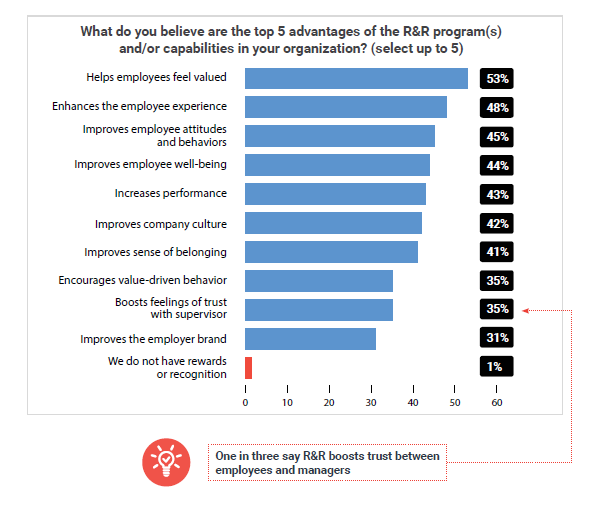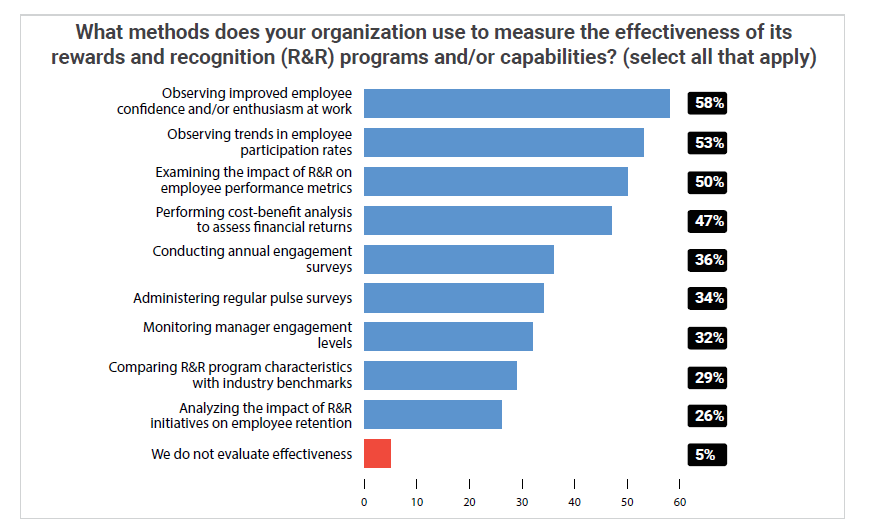HR.com’s State of Rewards and Recognition 2025
Maximize R&R impact by fostering a culture where employees feel valued
Posted on 05-13-2025, Read Time: 6 Min
Share:
.jpg)
Our research shows that seven in ten organizations have established strong recognition cultures, and eight in ten offer comprehensive rewards programs. Much like world-class athletes, these companies have dedicated effort, refined their strategies, and remained focused on performance.
But the race for excellence never ends. The best don’t just settle for the podium—they strive for new heights, aim for better results, and keep improving. Even with solid R&R programs in place, there’s always room to make recognition more personalized, meaningful, and impactful.
To better understand the current state and future direction of R&R, this report examines:
- the perceived level of effectiveness of R&R programs
- the top drivers of R&R and how programs are designed and implemented
- the most favored rewards and recognition among employees
- which metrics organizations track in relation to R&R, and the extent that R&R intersect with employee performance
- the extent to which programs are formal, who has responsibility for implementing programs, and the challenges associated with making them successful
- how R&R may evolve over the next two years, and the extent to which AI will play a role
- the practices typically associated with more successful R&R programs
The State of R&R Programs
When asked to rate the effectiveness of their organization’s rewards and recognition programs, nearly three-quarters (72%) of respondents gave a high or very high rating, highlighting the growing strength and impact of today’s R&R strategies.Key Drivers of R&R
So, what drives the need for strong rewards and recognition programs?While there are many benefits, the most common responses include:
- helps employees feel valued (53%)
- enhances employee experience (48%)
- improves employee attitudes and behaviors (45%)
- improves employee well-being (44%)
- increases performance (43%)
It’s encouraging that organizations prioritize making employees feel valued and enhancing their experiences. However, our recent study on the Future of Human Experience found that one-third rate their organization’s employee experience as a 6 or below on a 10-point scale (where 1 is terrible and 10 is top-notch). This suggests that investing in an R&R program can improve employee experiences, particularly in organizations where morale is low.

Today’s R&R Program Structures and Processes
Nearly half of organizations (47%) have formal rewards and recognition programs built on structured systems, ensuring consistency and minimizing bias.Another 40% strike a balance, blending formal and informal approaches to suit their culture and capabilities. When it comes to approvals, there's no one-size-fits-all model.
However, the Chief Human Resources Officer (CHRO) is most often in the driver’s seat, holding final say in 29% of organizations.

When looking at who’s most responsible for implementing R&R programs, the CHRO again leads the pack at 27%. Department heads follow (20%), with 15% pointing to HR business partners.
We asked respondents how closely tied rewards and recognition are to four factors: tenure, performance, values, and milestones.
- About three-quarters link R&R closely to tenure.
- Performance comes next, with 73% tying recognition to clear, measurable outcomes.
- Another 69% align R&R with company values to reinforce desired behaviors.
- Roughly two-thirds also recognize personal and professional milestones like anniversaries, marriages, or key achievements.
Measuring R&R Effectiveness
Nearly half (49%) assess their R&R programs quarterly, and 21% do so semi-annually, keeping efforts timely and effective.To measure success, 58% observe employee confidence and enthusiasm, while 53% monitor participation. Half track performance impact, and 47% use cost-benefit analyses to ensure ROI.

What Employees Want in R&R Programs
Our latest study on the State of Financial Wellness found debt is the most common financial stressor for employees. So, when we asked respondents of this study which rewards are most popular with employees, it is understandable that monetary-related incentives topped the list.
Challenges Impacting R&R Success
We asked respondents to highlight their top five challenges with R&R programs. The leading concern? A lack of measurable performance goals (36%), which makes it tough to track success and ensure fairness.Two other major hurdles—lack of managerial training (32%) and inconsistent application of R&R (32%)—often go hand in hand. Add to that a lack of transparency (31%) and poor communication or visibility (31%), and it’s clear why employees may feel disconnected from how recognition decisions are made. These challenges are frequently interrelated and call for strategic attention.
The Future of R&R Initiatives
Change is inevitable—but how will rewards and recognition evolve over the next two years? According to HR professionals, the most expected shifts include:- nurturing a culture that encourages R&R (46%)
- becoming more personalized (44%)
- becoming more just-in-time and on-the-spot (42%)
These developments reflect a growing emphasis on making recognition timely, authentic, and deeply relevant to employees.
That said, some areas still need more focus. For instance, 31% believe R&R will become more inclusive—an essential step, as lack of inclusivity can undermine the very motivation R&R aims to foster. Surprisingly, only 15% foresee better training for managers, despite it being the most cited challenge. Addressing this gap could significantly enhance program success.
Future of Technology and AI in R&R
We asked respondents to identify the top five ways technology will support their organization’s R&R program in the near future. Topping the list—both at 59%—were “improving ease of tracking and reporting” and “gaining better insights through analytics.”These advancements empower even non-data professionals to extract meaningful insights, making it easier to evaluate and refine R&R strategies.
Other leading responses include improving R&R communication to employees (52%), automating administrative tasks to reduce burden (51%), and overcoming the challenges of a geographically dispersed workforce (39%).
As workforces grow more global, organizations must find cost-effective and innovative ways to deliver consistent, meaningful recognition across regions.
For more insights and key takeaways, download the complete report.
Error: No such template "/CustomCode/topleader/category"!

